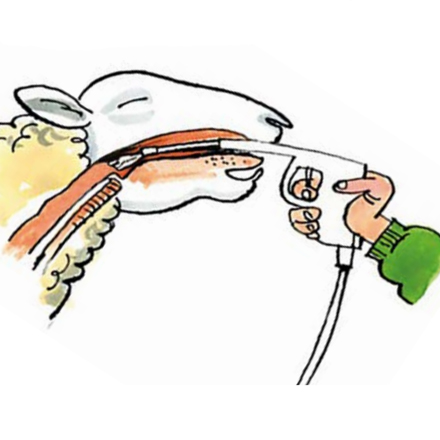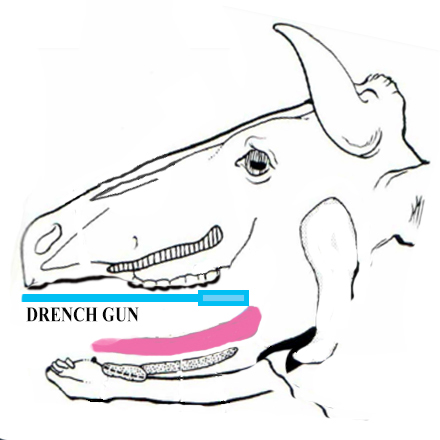Cobalt Sulphate is vital for ruminant animals, i.e. cattle, sheep, goats. Cobalt Sulphate helps the the enzymes of the gut by aiding in the production of vitamin B12. Vitamin B12 is vital for the gut microbes to convert the stomach contents into digestible matter that is used for energy and weight gain. Therefore, if cobalt is in short supply, this will restrict the manufacture of vitamin B12 and this will result in the lambs not being able to properly digest their food. Cobalt Sulphate can help keep cobalt levels up in animals by mixing it with water and giving it as an oral drench.
Cobalt Sulphate is vital for ruminant animals, i.e. cattle, sheep, goats.
Cobalt Sulphate helps the the enzymes of the gut by aiding in the production of vitamin B12.
Vitamin B12 is vital for the gut microbes to convert the stomach contents into digestible matter that is used for energy and weight gain.
Therefore, if cobalt is in short supply, this will restrict the manufacture of vitamin B12 and this will result in the lambs not being able to properly digest their food.
Cobalt Sulphate can help keep cobalt levels up in animals by mixing it with water and giving it as an oral drench.
Active Substance
Cobalt Sulphate
Target Species
Cattle Sheep and Goats
Treats and Controls
Aids in the production of Vitamin B12.
Application Method
Drench gun and mixing into water
Withdrawal Period
None
Dosage
30 ml per Ewe
Key Features of Cobalt Sulphate
Drench correctly
Sheep Oral Drench
The drenching technique is a vital part of ensuring that the wormer does its job effectively.
Make sure that the sheep are properly restrained and cannot leap around when they are being drenched so they swallow the whole amount.
Sheep can also suffer serious injury, or even death, if they are unrestrained and the gun penetrates the tissues at the back of the mouth.
Place a hand under the head and tilt slightly to the side.
Slot the nozzle in the gap between molar and incisor teeth and then over the back of the tongue.
If the operative just puts the wormer into the mouth, it will bypass the rumen as it escapes down the oesophageal groove and will be less effective.
This is particularly important for white (BZ) drenches.

Dosing Weigh – do not guess Underestimating the weight of sheep is a common cause of underdosing.
Select and weigh the biggest sheep in the group to determine the correct dose.
If there is a wide range of weights, consider splitting the group, then weigh the heaviest in each section.
Do not forget to check that the weigh crate is accurate before starting!
Calibrate and maintain the drench gun
Always check the gun is delivering the right amount before you drench.
Remove the plunger from a 10 ml syringe, put a thumb over the end and squirt the dose into it, making sure there are no air bubbles left.
Adjust the gun until the dose delivered is correct.
Drenching guns should also be well maintained and replaced regularly.
Clean with warm soapy water after use and check springs and tubes to make sure there are no kinks that will form air bubbles.
Withholding food
Research has shown that the efficacy of the white (BZ) and clear (AV) drenches can be improved by withholding food for 12–24 hours before treatment.
It is not advised to deprive heavily pregnant ewes of food, so if you treat this class of stock with anthelmintics, you may wish to use yellow drenches (LV) because their efficacy is less dependent on rumen fill.
Storage
Wormers should be stored securely, away from direct sunlight at 4–25°C.
Check the use-by date and, once open, use within the time shown on the packaging.
Shake white (BZ) products well before use.
Cattle Oral drenches
Oral drenching guns are designed to deliver the treatment towards the back of the mouth over the tongue, so the entire dose is swallowed at once to optimise efficacy.
• Make sure animals are properly restrained, with their head held up • Slide the nozzle of the dosing gun in the side of the mouth and over the tongue so that the entire dose is swallowed immediately
• Drenching equipment must be correctly calibrated and in good working order
• Calibrate the gun using the product just before treatment starts by delivering two or more doses into a graduated measuring cylinder.
Faulty equipment, or attempting to dose too quickly, may mean that the barrel of the gun does not fill properly or that the liquid is full of bubbles.

Dosing Weigh – do not guess Underestimating the weight of sheep is a common cause of underdosing.
Select and weigh the biggest sheep in the group to determine the correct dose.
If there is a wide range of weights, consider splitting the group, then weigh the heaviest in each section.
Do not forget to check that the weigh crate is accurate before starting!
Calibrate and maintain the drench gun
Always check the gun is delivering the right amount before you drench.
Remove the plunger from a 10 ml syringe, put a thumb over the end and squirt the dose into it, making sure there are no air bubbles left.
Adjust the gun until the dose delivered is correct.
Drenching guns should also be well maintained and replaced regularly.
Clean with warm soapy water after use and check springs and tubes to make sure there are no kinks that will form air bubbles.
Withholding food
Research has shown that the efficacy of the white (BZ) and clear (AV) drenches can be improved by withholding food for 12–24 hours before treatment.
It is not advised to deprive heavily pregnant ewes of food, so if you treat this class of stock with anthelmintics, you may wish to use yellow drenches (LV) because their efficacy is less dependent on rumen fill.
Storage
Wormers should be stored securely, away from direct sunlight at 4–25°C.
Check the use-by date and, once open, use within the time shown on the packaging.
Shake white (BZ) products well before use.
Would you like to send this voucher to the recipient via email?
Yes No